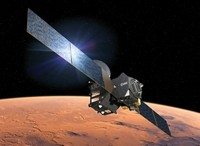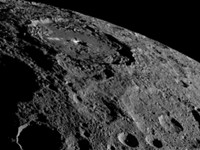Advertisement
Grab your lab coat. Let's get started
Welcome!
Welcome!
Create an account below to get 6 C&EN articles per month, receive newsletters and more - all free.
It seems this is your first time logging in online. Please enter the following information to continue.
As an ACS member you automatically get access to this site. All we need is few more details to create your reading experience.
Not you? Sign in with a different account.
Not you? Sign in with a different account.
ERROR 1
ERROR 1
ERROR 2
ERROR 2
ERROR 2
ERROR 2
ERROR 2
Password and Confirm password must match.
If you have an ACS member number, please enter it here so we can link this account to your membership. (optional)
ERROR 2
ACS values your privacy. By submitting your information, you are gaining access to C&EN and subscribing to our weekly newsletter. We use the information you provide to make your reading experience better, and we will never sell your data to third party members.
Physical Chemistry
Martian Views
New studies bolster the case for the former presence of liquid water
by Elizabeth K. Wilson
May 25, 2009
| A version of this story appeared in
Volume 87, Issue 21

TWO NEW REPORTS weigh in on the climate of early Mars. One concludes that the early planet was warm, the other that it was cold, but both suggest the planet was wet.
An internationsl team of scientists led by Cornell University's Stephen W. Squyres reports that during two years of exploration, NASA's Mars Rover Opportunity found that compositional features, apparently altered by liquid water in the exposed walls of Mars's Victoria impact crater, match those of two other impact craters—Eagle and Endurance—several miles away. This suggests, the researchers say, that the same groundwater processes affected large regions of terrain on a warm planet (Science 2009, 324, 1058). For example, the craters all show, among other things, sulfate salts, which likely were produced by the interaction of basalt with acidic water.
In the second report, NASA Ames Research Center astrobiologist Christopher P. McKay and colleagues take aim at recent work that suggests Mars has always been too frigid to support liquid water (C&EN, Dec. 1, 2008, page 59). Using chemical composition data gathered at various Mars landing sites, the group found that a collection of dissolved species, including silicon, iron, sulfur, calcium, and aluminum, could suppress the temperature at which water freezes to below 273 K, thereby allowing liquid water to exist on the early planet (Nature 2009, 459, 401).
A model McKay's group developed indicates that minerals that would be formed from those dissolved species after millennia of weathering processes match minerals actually found on Mars, adding further credence to the idea that liquid water was present on the frigid young planet.





Join the conversation
Contact the reporter
Submit a Letter to the Editor for publication
Engage with us on Twitter